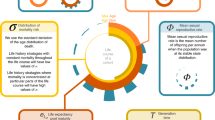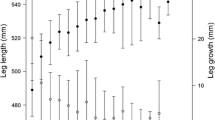Abstract
This study tested an emergent prediction from the Metabolic Theory of Ecology (MTE) that the age at first reproduction (α) of a mammal is proportional to the inverse of its mass-corrected basal metabolic rate: \( \alpha \propto (B/M)^{ - 1}. \) The hypothesis was tested with multiple regression models of conventional species data and phylogenetically independent contrasts of 121 mammal species. Since age at first reproduction is directly influenced by an individual’s growth rate, the hypothesis that growth rate is proportional to BMR was also tested. Although the overall multiple regression model was significant, age at first reproduction was not partially correlated with either body mass, growth rate or BMR. Similarly, growth rate was not correlated with BMR. Thus at least for mammals in general, there is no evidence to support the fundamental premise of the MTE that individual metabolism governs the rate at which energy is converted to growth and reproduction at the species level. The exponents of the BMR allometry calculated using phylogenetic generalized least squares regression models were significantly lower than the three-quarter value predicted by the MTE.




Similar content being viewed by others
References
Allen AP, Gillooly JF (2006) Assessing latitudinal gradients in speciation rates and biodiversity at the global scale. Ecol Lett 9:947–954
Aschoff J (1986) Circadiane systeme. Physiologie Aktuell 2:5–19
Bennett AF, Ruben JA (1979) Endothermy and activity in vertebrates. Science 206:649–654
Bininda-Emonds ORP, Cardillo M, Jones KE, Macphee RDE, Beck RMD, Grenyer R, Price SA, Vos RA, Gittleman JL, Purvis A (2007) The delayed rise of present-day mammals. Nature 446:507–512
Blomberg SP, Garland T, Ives AR (2003) Testing for phylogenetic signal in comparative data: behavioural traits are more labile. Evolution 57:717–745
Boix-Hinzen C, Lovegrove BG (1998) Circadian metabolic and thermoregulatory patterns of red-billed woodhoopoes (Phoeniculus purpureus): the influence of huddling. J Zool Lond 244:33–41
Brown JH (2004) Towards a metabolic theory of ecology. Ecology 85:1771–1789
Chown SL, Marais E, Terblanche JS, Klok CJ, Lighton JB, Blackburn TM (2007) Scaling of insect metabolic rate is inconsistent with the nutrient supply network model. Funct Ecol 21:282–290
Clarke A (2006) Temperature and the metabolic theory of ecology. Funct Ecol 20:405–412
Clarke A, Fraser KPP (2007) Why does metabolism scale with temperature? Funct Ecol 18:243–251
Clarke A, Johnston NM (1999) Scaling of metabolic rate with body mass and temperature in teleost fish. J Anim Ecol 68:893–905
Darveau C-A, Suarez F, Andrews RD, Hochachka PW (2002) Allometric cascade as a unifying principle of body mass effects on metabolism. Nature 417:166–170
del Río CM (2008) Metabolic theory or metabolic models? Tree 23:256–260
Dewar RE, Richard AF (2007) Evolution in the hypervariable environment of Madagascar. Proc Natl Acad Sci USA 104:13723–13727
Duncan RP, Forsyth DA, Hone J (2007) Testing the metabolic theory of ecology: allometric scaling exponents in mammals. Ecology 88:324–333
Ernest SKM (2003) Life history characteristics of placental nonvolant mammals. Ecology 84:3402
Farmer CG (2000) Parental care: the key to understanding endothermy and other convergent features in birds and mammals. Am Nat 155:326–334
Feder ME, Block BA (1991) On the future of animal physiological ecology. Funct Ecol 5:136–144
Feder ME, Bennett AF, Huey RB (2000) Evolutionary physiology. Annu Rev Ecol Syst 31:315–341
Felsenstein J (1985) Phylogenies and the comparative method. Am Nat 125:1–15
Freckleton RP (2002) On the misuse of residuals in ecology: regression of residuals vs. multiple regression. J Anim Ecol 71:542–545
Garland T, Ives AR (2000) Using the past to predict the present: confidence intervals for regression equations in phylogenetic comparative methods. Am Nat 155:346–365
Garland T, Harvey PH, Ives AR (1992) Procedures for the analysis of comparative data using phylogenetically independent contrasts. Syst Biol 41:18–32
Gillooly JF, Brown JH, West GB, Savage VM, Charnov EL (2001) Effects of size and temperature on metabolic rate. Science 293:2248–2251
Gillooly JF, Charnov EL, West GB, Savage VM, Brown JH (2002) Effects of size and temperature on development time. Nature 417:70–73
Gillooly JF, Allen AP, Savage VM, Charnov EL, West GB, Brown JH (2006) Response to Clarke and Fraser: effects of temperature on metabolic rate. Funct Ecol 20:400–404
Glazier DS (2005) Beyond the ‘3/4-power law’; variation in the intra- and interspecific scaling of metabolic rate in mammals. Biol Rev 80:611–662
Harvey PH, Pagel MD (1991) The comparative method in evolutionary biology. Oxford University Press, Oxford
Harvey PH, Read AF, Promislow DEL (1989) Life history variation in placental mammals: unifying the data with theory. Oxf Surv Evol Biol 6:13–32
Harvey PH, Pagel MD, Rees JA (1991) Mammalian metabolism and life histories. Am Nat 137:556–566
Harvey PH, Read AF, Nee S (1995) Why ecologists need to be phylogenetically challenged. J Ecol 83:535–536
Hayssen V, Lacy RC (1985) Basal metabolic rates in mammals: taxonomic differences in the allometry of BMR and body mass. Comp Biochem Physiol 81A:741–754
Hochachka PW, Darveau C-A, Andrews RD, Suarez RK (2003) Allometric cascade: a model for resolving body mass effects on metabolism. Comp Biochem Physiol A 134:675–691
Huchon D, Douzery EJP (2001) From the old world to the new world: a molecular chronicle of the phylogeny and biogeography of Hystricognath rodents. Mol Phylogenet Evol 20:238–251
Jaarola M, Martinkova N, Gunduz I, Brunhoff C, Zima J, Nadachowski A, Amori G, Bulatova NS, Chondropoulos B, Fraguedakis-Tsolis S, Gonzalez-Esteban J, Lopez-Fuster MJ, Kandaurov AS, Kefelioglu H, Mathias MD, Villate I, Searle JB (2004) Molecular phylogeny of the speciose vole genus Microtus (Arvicolinae, Rodentia) inferred from mitochondrial DNA sequences. Mol Phylogenet Evol 33:647–663
Kalcounis-Rueppell MC (2007) Relationship of basal metabolism and life history attributes in Neotomine-Peromyscine rodents (Cricetidae: Neotominae). Ecoscience 14:347–356
Koteja P (2004) The evolution of concepts on the evolution of endothermy in birds and mammals. Physiol Biochem Zool 77:1043–1050
Kozlowski J, Konarzewski M (2004) Is west, Brown and Enquist’s model of allometric scaling mathematically correct and biologically relevant? Funct Ecol 18:283–289
Kozlowski J, Konarzewski M, Gawelczyk AT (2003) Cell size as a link between noncoding DNA and metabolic rate scaling. Proc Natl Acad Sci USA 100:14080–14085
Lavin SR, Karasov WH, Ives AR, Middleton KM, Garland T (2008) Morphometrics of the avian small intestine compared with that of nonflying mammals: a phylogenetic approach. Physiol Biochem Zool 81:526–550
Liu C, Li S, Liu T, Borjigin J, Lin JD (2007) Transcriptional coactivator PGC-1á integrates the mammalian clock and energy metabolism. Nature 447:477–482
Lovegrove BG (2000) The zoogeography of mammalian basal metabolic rate. Am Nat 156:201–219
Lovegrove BG (2003) The influence of climate on the basal metabolic rate of small mammals: a slow-fast metabolic continuum. J Comp Physiol B 173:87–112
Lovegrove BG (2005) Seasonal thermoregulatory responses in mammals. J Comp Physiol B 175:231–247
Lovegrove BG (2006) The power of fitness in mammals: perspectives from the African slipstream. Physiol Biochem Zool 79:224–236
Lovegrove BG, Heldmaier G (1994) The amplitude of circadian body temperature rhythms in three rodents (Aethomys namaquensis, Thallomys paedulcus and Cryptomys damarensis) along an arboreal-subterranean gradient. Aust J Zool 42:65–78
McKechnie AE, Lovegrove BG (1999) Circadian metabolic responses to food deprivation in the black-shouldered kite. Condor 101:426–432
McNab BK (1980) Food habits, energetics, and the population biology of mammals. Am Nat 116:106–124
McNab BK (1986) The influence of food habits on the energetics of eutherian mammals. Ecol Monogr 56:1–19
McNab BK (2002) The physiological ecology of vertebrates: a view from energetics. Cornell University Press, Ithaca
O’Conner MP, Agosta SJ, Hansen F, Kemp SJ, Sieg AE, McNair JN, Dunham AE (2007) Phylogeny, regression, and the allometry of physiological traits. Am Nat 170:431–442
Price CA, Enquist BJ (2007) Scaling mass and morphology in leaves: an extension of the WBE Model. Ecology 88:1132–1141
Promislow DEL, Harvey PH (1990) Living fast and dying young: a comparative analysis of life-history variation among mammals. J Zool Lond 220:417–437
R Development Core Team (2007) R: a language and environment for statistical computing. R Foundation for Statistical Computing, Vienna. ISBN 3-900051-07-0, URL http://www.R-project.org
Read AF, Harvey PH (1989) Life history differences among the eutherian radiations. J Zool Lond 219:329–353
Rezende EL, Bozinovic F, Garland T (2004) Climatic adaptation and the evolution of basal and maximum rates of metabolism in rodents. Evolution 58:1361–1374
Rolfe DFS, Brown GC (1997) Cellular energy utilization and molecular origin of standard metabolic rate in mammals. Physiol Rev 77:731–758
Rowe DL, Honeycutt RL (2002) Phylogenetic relationships, ecological correlates, and molecular evolution within the Cavioidea (Mammalia, Rodentia). Mol Biol Evol 19:263–277
Savage VM, Gillooly JF, Brown JH, West GB, Charnov EL (2004a) Effects of body size and temperature on population growth. Am Nat 163:429–441
Savage VM, Gillooly JF, Woodruff WH, West GB, Allen AP, Enquist BJ, Brown JH (2004b) The predominance of quarter-power scaling in biology. Funct Ecol 18:257–282
Stearns SC (1992) The evolution of life histories. Oxford University Press, Oxford
Steppan SJ, Adkins RM, Anderson J (2004) Phylogeny and divergence-date estimates of rapid radiations in muroid rodents based on multiple nuclear genes. Syst Biol 53:533–553
Symonds MRE (1999) Life histories of the Insectivora: the role of phylogeny, metabolism and sex differences. J Zool Lond 249:315–337
Warton DI, Wright IJ, Falster DS, Westoby M (2006) Bivariate line-fitting methods for allometry. Biol Rev 81:259–291
West GB, Brown JH, Enquist BJ (1997) A general model for the origin of allometric scaling laws in biology. Science 276:122–126
West GB, Brown JH, Enquist BJ (2001) A general model for ontogenetic growth. Nature 413:628–631
West GB, Brown JH, Enquist BJ (2004) Growth models based on first principles or phenomenology? Funct Ecol 18:188–196
White CR, Seymour RS (2003) Mammalian basal metabolic rate is proportional to body mass 2/3. Proc Natl Acad Sci USA 100:4046–4049
White CR, Seymour RS (2004) Does basal metabolic rate contain a useful signal? Mammalian BMR allometry and correlations with a selection of physiological ecological, and life history variables. Physiol Biochem Zool 77:929–941
White CR, Blackburn TM, Martin GR, Butler PJ (2007) Basal metabolic rate of birds is associated with habitat temperature and precipitation, not primary productivity. Proc R Soc Lond B 274:287–293
Wiersma P, Muñoz-Garcia A, Walker A, Williams JB (2007) Tropical birds have a slow pace of life. Proc Natl Acad Sci USA 104:9340–9345
Wijnen H, Young MW (2006) Interplay of circadian clocks and metabolic rhythms. Annu Rev Genet 40:409–448
Withers PC, Cooper CE, Larccombe AN (2006) Environmental correlates of physiological variables in marsupials. Physiol Biochem Zool 79:437–453
Zullinger EM, Ricklefs RE, Redford KH (1984) Fitting sigmoidal equations to mammalian growth curves. J Mammals 65:607–636
Acknowledgments
This research was financed by publication incentive grants from the University of KwaZulu-Natal Research Office.
Author information
Authors and Affiliations
Corresponding author
Additional information
Communicated by G. Heldmaier.
Electronic supplementary material
Below is the link to the electronic supplementary material.
Rights and permissions
About this article
Cite this article
Lovegrove, B.G. Age at first reproduction and growth rate are independent of basal metabolic rate in mammals. J Comp Physiol B 179, 391–401 (2009). https://doi.org/10.1007/s00360-008-0322-4
Received:
Revised:
Accepted:
Published:
Issue Date:
DOI: https://doi.org/10.1007/s00360-008-0322-4




